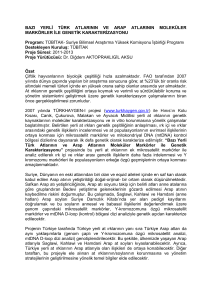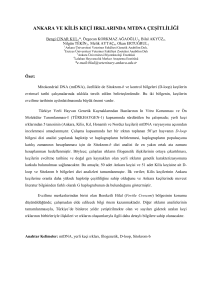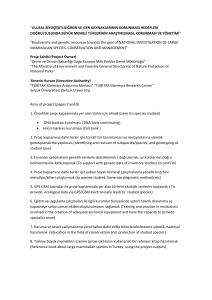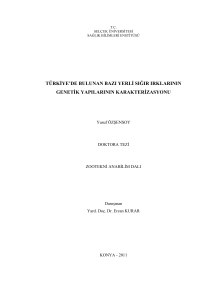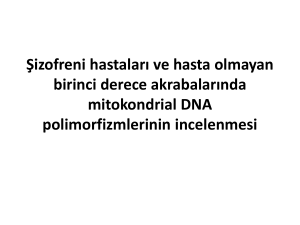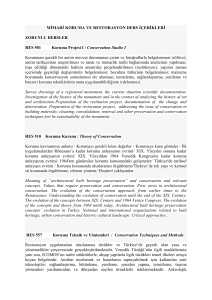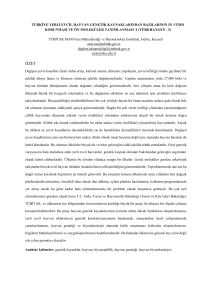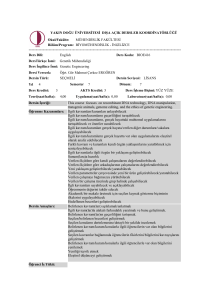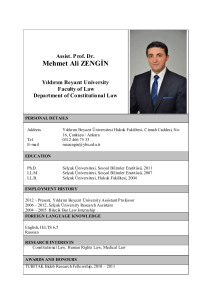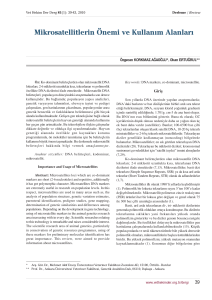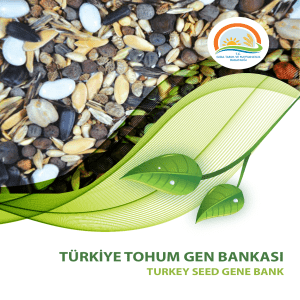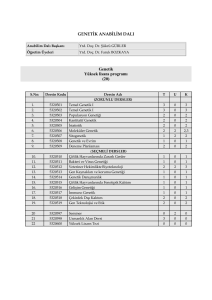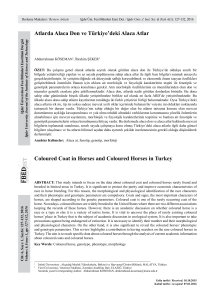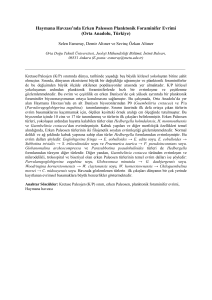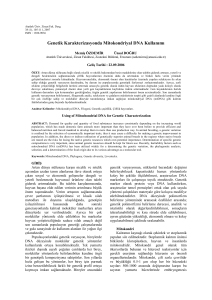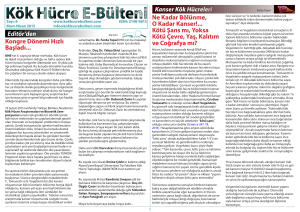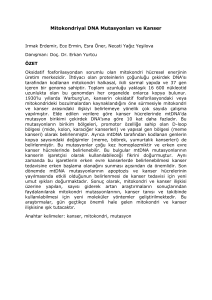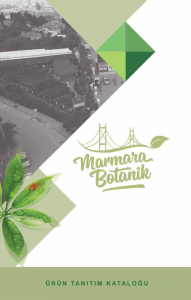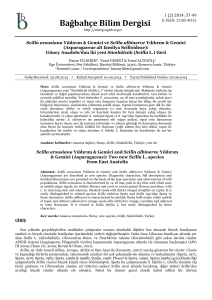THE CONSERVATION OF GENETIC DIVERSITY IN TURKISH
advertisement
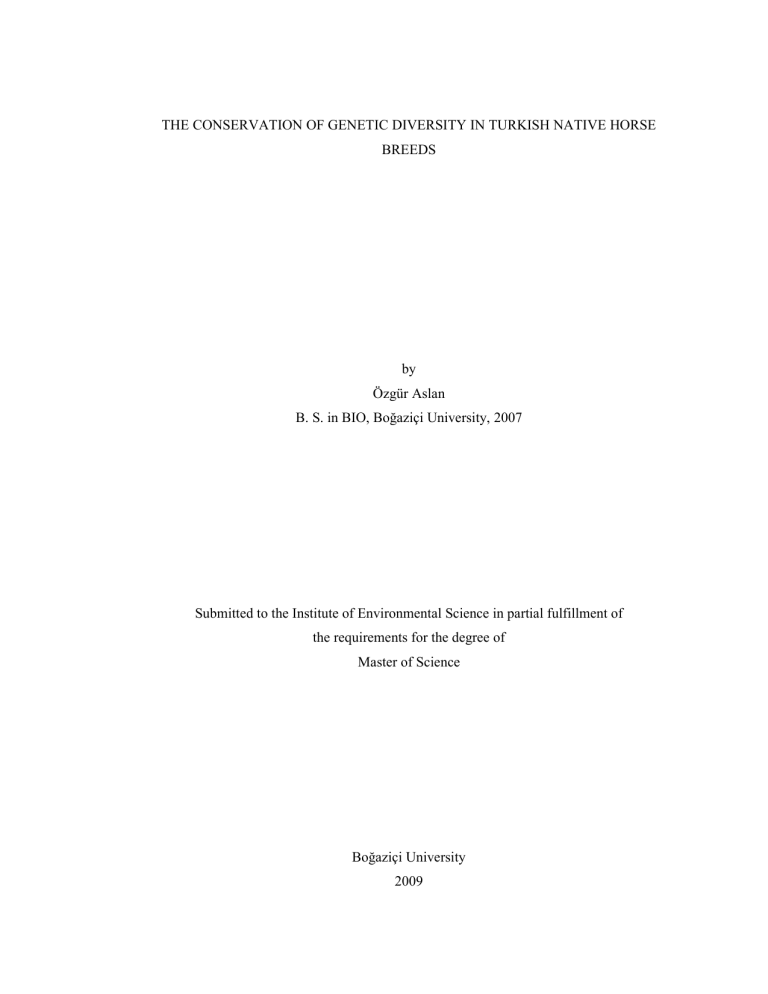
THE CONSERVATION OF GENETIC DIVERSITY IN TURKISH NATIVE HORSE BREEDS by Özgür Aslan B. S. in BIO, Boğaziçi University, 2007 Submitted to the Institute of Environmental Science in partial fulfillment of the requirements for the degree of Master of Science Boğaziçi University 2009 ii THE CONSERVATION OF GENETIC DIVERSITY IN TURKISH NATIVE HORSE BREEDS APPROVED BY: Assist. Prof. Raşit Bilgin .......................................... (Thesis Supervisor) Assoc. Prof. Sezen Arat .......................................... (Thesis Co-supervisor) Prof. Işıl Balcıoğlu ......................................... Dr. Evren Koban .......................................... Prof. Orhan Yenigün .......................................... DATE OF APPROVAL: iii ACKNOWLEDGMENTS iv ABSTRACT THE CONSERVATION OF GENETIC DIVERSITY IN TURKISH NATIVE HORSE BREEDS In the last two decade, the loss of animal genetic resources, as an inevitable result of the decrease both in the number of species and in the population size, has become an important issue and many countries have prepared their own action plan concerning the conservation strategies on the basis of FAO’s global management program. Although, wild species generally have been prioritized in the conservation studies, domesticated animals should also be considered as a part of the present biodiversity. Identifying genetic compositions of species is the first step of subsequent breeding programs and conservation studies. The domestication events of several animal species namely sheep, cattle and goat were carried out in Anatolia. Even though the Anatolian peninsula is located within several immigration and trade routes between the east and the west, and horses were used for transportation and warfare, there have been no studies concerning the origins and the evolutionary processes of Turkish native livestock horse breeds based on DNA markers. In this study, 319 base pairs of the mitochondrial DNA (mtDNA) D-loop region of 317 horse samples representing five phenotypically distinct Turkish native horse breeds was analyzed, genetically characterized and to set up the basis for a conservation program. According to the number of variable sites identified within D-loop region, Turkish native horse breeds have high haplotype, and low nucleotide diversities. In addition, because of the high motility of horses, inappropriate horse trading habits, and lack of proper breeding strategies for horses in Turkey, significant genetic separations were not observed among horse breeds. A phylogenetic network constructed based on mtDNA sequences including various Turkish native livestock horses and GenBank sequences representing seven previously published haplogroups showed that Turkish horse breeds clustered into these seven clades and one additional unique clade which could be named as an eighth haplogroup. mtDNA analysis of Turkish horses also indicates the presence of many ancient maternal lineages within. 5 ÖZET YERLĐ TÜRK ATLARINDA GENETĐK ÇEŞĐTLĐLĐĞĐN KORUNMASI Son yıllarda, hayvan türü sayısındakive populasyon ve populasyon büyüklüğündeki azalmanın kaçınılmaz sonucu olan genetik kaynakların kaybedilmesi, önemli bir konu haline gelmiştir ve birçok ülke FAO’nun hazırladığı global yönetim progmına uygun olarak kendi koruma stratejilerini oluşturmuştur. Vahşi hayvanlara genel olarak koruma programlarında öncelik verilmesine rağmen, evcil hayvanlar da biyo-çeşitliliğin parçası olarak kabul edilmeli ve koruma programlarına eklenmelilerdir. Türlerin genetik yapılarının incelenmesi koruma programlarının ve tohumlama stratejilerinin ilk adımıdır. Koyun, keçi ve sığır türlerinin evcilleştirilmesi Anadolu’da gerçekleştirilmiştir. Geçmişte Anadolu yarım adası birçok göç ve ticaret yolunda bulunmasına ve atların taşımada ve savaşta kullanılmalarına rağmen, Türk yerli at ırkları hakkında genetik işaretleyicileri kullanılarak şu ana kadar herhangi bir çalışma yapılmamıştır. Bu çalışmada, ırkların genetik karakterizasyonunun yapılması ve koruma programının temellendirilmesi için beş adet Türk at ırkını temsil eden 317 at örneğinin 319 baz çiftlik mitokondriyal D-loop bölgesi kullanılmıştır. Farklılık gösteren D-loop bölgelerinin analizi sonucunda, yerli Türk at ırklarının haplotip çeşitliliğinin yüksek olduğu ve nükleotid bilgisinin düşük olduğu bilgisine ulaşılmıştır. Bunun yanı sıra, uygun olmayan yüksek at haraketliliği ve atlar için tohumlama stratejisinin olamaması sebebiyle, ırklar arasında geçerli bir ayrılma gözlemlenmemiştir. Yerli Türk atları ve daha önce yayınlanmış yedi adet haplogrubu temsil eden 22 örnek kullanılarak bir tane filogenetik ağ oluşturulmuştur. Türk atları, A-G olarak isimlendirilen bu yedi grupta ve sekizinci grup olarak adlandırılabilecek olan farklı bir grupta toplanmıştır. Ek olarak, Türk atlarının mtDNA analizleri, atların evcilleştirilmesi sürecine bir çok atasal kısrak ırkının dahil olduğunu doğrulamıştır.
